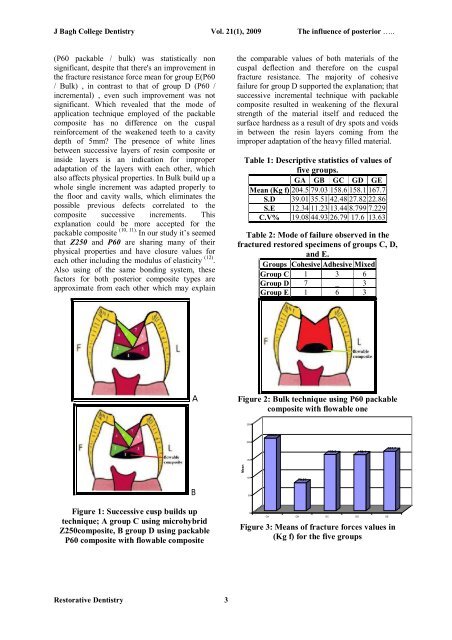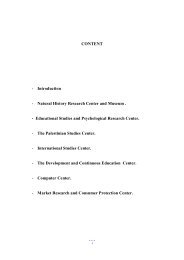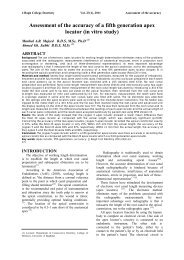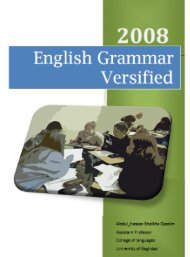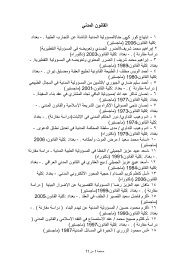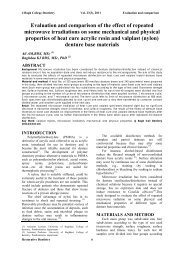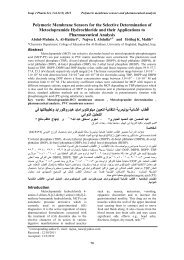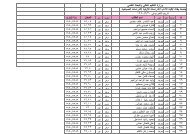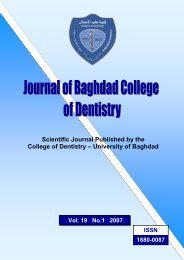Vol 21 No. 1
Vol 21 No. 1
Vol 21 No. 1
You also want an ePaper? Increase the reach of your titles
YUMPU automatically turns print PDFs into web optimized ePapers that Google loves.
J Bagh College Dentistry <strong>Vol</strong>. <strong>21</strong>(1), 2009 The influence of posterior …..<br />
(P60 packable / bulk) was statistically non<br />
significant, despite that there's an improvement in<br />
the fracture resistance force mean for group E(P60<br />
/ Bulk) , in contrast to that of group D (P60 /<br />
incremental) , even such improvement was not<br />
significant. Which revealed that the mode of<br />
application technique employed of the packable<br />
composite has no difference on the cuspal<br />
reinforcement of the weakened teeth to a cavity<br />
depth of 5mm? The presence of white lines<br />
between successive layers of resin composite or<br />
inside layers is an indication for improper<br />
adaptation of the layers with each other, which<br />
also affects physical properties. In Bulk build up a<br />
whole single increment was adapted properly to<br />
the floor and cavity walls, which eliminates the<br />
possible previous defects correlated to the<br />
composite successive increments. This<br />
explanation could be more accepted for the<br />
packable composite (10, 11). In our study it’s seemed<br />
that Z250 and P60 are sharing many of their<br />
physical properties and have closure values for<br />
each other including the modulus of elasticity (12) .<br />
Also using of the same bonding system, these<br />
factors for both posterior composite types are<br />
approximate from each other which may explain<br />
the comparable values of both materials of the<br />
cuspal deflection and therefore on the cuspal<br />
fracture resistance. The majority of cohesive<br />
failure for group D supported the explanation; that<br />
successive incremental technique with packable<br />
composite resulted in weakening of the flexural<br />
strength of the material itself and reduced the<br />
surface hardness as a result of dry spots and voids<br />
in between the resin layers coming from the<br />
improper adaptation of the heavy filled material.<br />
Table 1: Descriptive statistics of values of<br />
five groups.<br />
GA GB GC GD GE<br />
Mean (Kg f) 204.5 79.03 158.6 158.1 167.7<br />
S.D 39.01 35.51 42.48 27.82 22.86<br />
S.E 12.34 11.23 13.44 8.799 7.229<br />
C.V% 19.08 44.93 26.79 17.6 13.63<br />
Table 2: Mode of failure observed in the<br />
fractured restored specimens of groups C, D,<br />
and E.<br />
Groups Cohesive Adhesive Mixed<br />
Group C 1 3 6<br />
Group D 7 _ 3<br />
Group E 1 6 3<br />
A<br />
Figure 2: Bulk technique using P60 packable<br />
composite with flowable one<br />
250<br />
204,5<br />
200<br />
158,6 158,1<br />
167,7<br />
150<br />
Mean<br />
100<br />
79,03<br />
Figure 1: Successive cusp builds up<br />
technique; A group C using microhybrid<br />
Z250composite, B group D using packable<br />
P60 composite with flowable composite<br />
B<br />
50<br />
0<br />
GA GB GC GD GE<br />
Figure 3: Means of fracture forces values in<br />
(Kg f) for the five groups<br />
Restorative Dentistry 3


